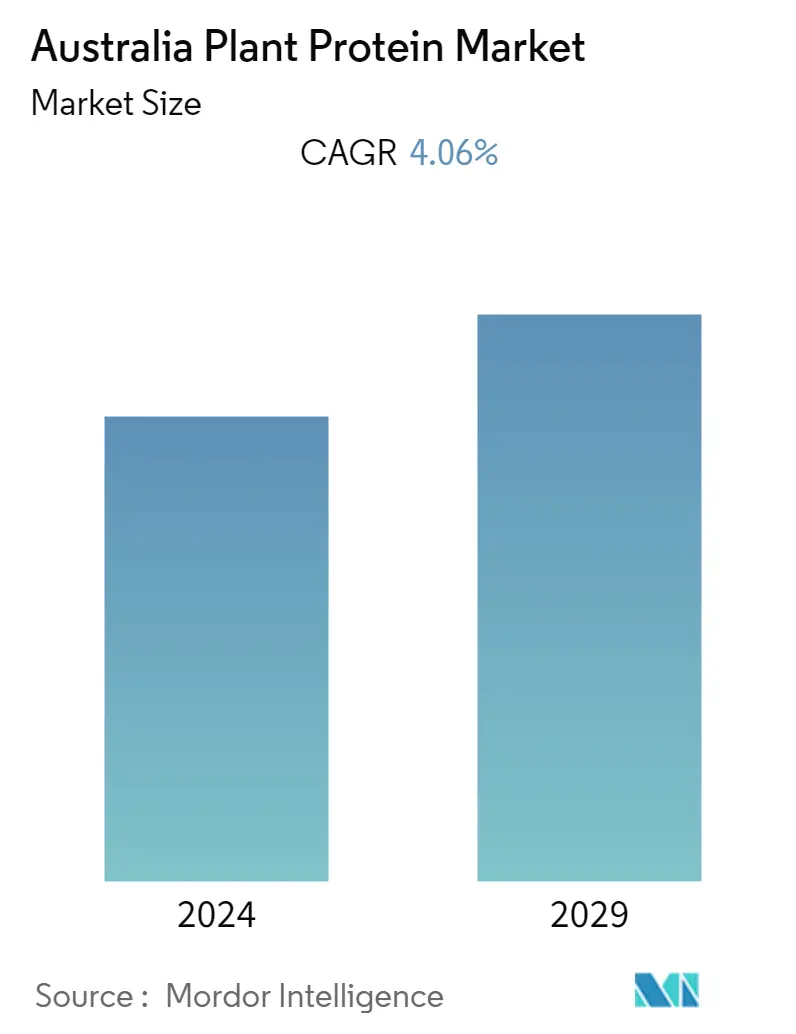Market Size of Australia Plant Protein Industry

| Study Period | 2019 - 2029 |
| Base Year For Estimation | 2023 |
| Forecast Data Period | 2024 - 2029 |
| Historical Data Period | 2019 - 2022 |
| CAGR | 4.06 % |
| Market Concentration | Low |
Major Players
*Disclaimer: Major Players sorted in no particular order |
Australia Plant Protein Market Analysis
The Australia protein market size is expected to grow from USD 124.51 million in 2023 to USD 151.93 million by 2028, at a CAGR of 4.06% during the forecast period.
- The market for plant proteins has been emerging in Australia as a result of increased demand brought on by growing public knowledge of the advantages of consuming proteins sourced from plant-based sources and growing attention towards the disadvantages of animal proteins.
- According to the AltProteins22 Conference in May 2022, Australia was poised to become a major participant in the world of plant-based proteins. The Victorian government sponsored the first alternative proteins conference for Australia and New Zealand, AltProteins22. Australia is in a position to create new protein companies that will be profitable when consumer trends and new protein sectors build up.
- In addition to traditional protein sectors that have shifted their attention to export markets, the alternative proteins industry is already creating jobs, stimulating the Australian economy, and opening up new agrifood opportunities. These factors are driving the market studied in Australia. Australian youth population tend to be more inclined towards fitness activities.
- Hence, the growth of health consciousness, joining gyms and other fitness clubs, increasing sports participation, etc., is expected to drive the demand for protein-rich foods across the region. The rising demand for protein-rich foods coupled with a preference for clean-label products is expected to play a crucial role in driving the plant protein market in Australia.
- The innovations of products with plant protein ingredients such as protein bars, shakes, juices, and smoothies, also offer ample opportunities for the expansion of the plant protein market in Australia. For instance, in August 2021, Greenback, an Australia-based company, launched a range of plant-based protein bars that were initially sold in 7,000 retailers in Australia. Hence, the increase in innovation of products using plant-based protein ingredients and penetration of such products in the market are expected to drive Australia's plan.
- Additionally, due to the population's hectic schedules in metropolises and megacities, ready-to-drink protein product consumption has significantly expanded. The players in the protein alternative market are dedicated to offering nutrient-dense foods. These trends among the customers are also driving the demand for protein alternatives in the Australian market.
Australia Plant Protein Industry Segmentation
Plant proteins are derived from plant sources like peas, brown rice, legumes, hemp, soy, flaxseeds, and chia seeds, among others.
Australia's plant protein market is segmented into protein type and end-user. By protein type, the market is segmented into hemp protein, pea protein, potato protein, rice protein, soy protein, wheat protein, and other plant protein. Based on end-users, the market is segmented into animal feed, personal care and cosmetics, food and beverages, and supplements. The food and beverages segment of the market studied is further segmented into bakery, beverages, breakfast cereals, condiments/sauces, confectionery, dairy and dairy alternative products, meat/poultry/seafood and meat alternative products, RTE/RTC food products, and snacks. The supplement segment among the end users is further segmented into baby food and infant nutrition, elderly nutrition and medical nutrition, and sport/performance nutrition.
The market sizing has been done in value terms in USD and for volume terms in volume in tons for all the abovementioned segments.
| Protein Type | |
| Hemp Protein | |
| Pea Protein | |
| Potato Protein | |
| Rice Protein | |
| Soy Protein | |
| Wheat Protein | |
| Other Plant Protein |
| End-User | |||||||||||
| Animal Feed | |||||||||||
| Personal Care and Cosmetics | |||||||||||
| |||||||||||
|
Australia Plant Protein Market Size Summary
The Australian plant proteins market is experiencing significant growth, driven by increasing consumer awareness of the benefits of plant-based proteins and a shift away from animal proteins due to health and environmental concerns. The market is characterized by a rising demand for vegan food and beverages, supported by a growing number of consumers adopting plant-based diets. This trend is further fueled by the health benefits associated with plant proteins, such as cholesterol-free options and improved glucose tolerance. The market is also benefiting from innovations in plant-based products, including protein bars, shakes, and smoothies, which are gaining popularity among health-conscious consumers and those with busy lifestyles. The availability of local raw materials, such as soybeans and peas, is enhancing the production capabilities of plant protein manufacturers, allowing them to meet the increasing demand and achieve economies of scale.
The competitive landscape of the Australian plant proteins market is fragmented, with numerous players actively expanding their production capacities and focusing on innovative offerings to capture market share. Major companies like Bunge Limited, International Flavors & Fragrances Inc., Cargill Incorporated, and Kerry Group Plc are investing in research and development to enhance their product portfolios and cater to the growing demand for plant-based ingredients. Strategic initiatives such as mergers, acquisitions, and the establishment of innovation centers are being employed to strengthen their market positions. The market's growth is also supported by the increasing participation of the Australian population in fitness activities, which drives the demand for protein-rich foods. As consumer preferences continue to shift towards clean-label and sustainable products, the plant proteins market in Australia is poised for continued expansion.
Australia Plant Protein Market Size - Table of Contents
-
1. MARKET DYNAMICS
-
1.1 Market Drivers
-
1.1.1 Increasing Demand for Vegan Food & Beverages Driving the Market
-
1.1.2 Intolerance and Allergies Associated with Animal Protein Products
-
-
1.2 Market Restraints
-
1.2.1 High Market Penetration of Animal Protein
-
-
1.3 Porter's Five Forces Analysis
-
1.3.1 Threat of New Entrants
-
1.3.2 Bargaining Power of Buyers/Consumers
-
1.3.3 Bargaining Power of Suppliers
-
1.3.4 Threat of Substitute Products
-
1.3.5 Intensity of Competitive Rivalry
-
-
-
2. MARKET SEGMENTATION
-
2.1 Protein Type
-
2.1.1 Hemp Protein
-
2.1.2 Pea Protein
-
2.1.3 Potato Protein
-
2.1.4 Rice Protein
-
2.1.5 Soy Protein
-
2.1.6 Wheat Protein
-
2.1.7 Other Plant Protein
-
-
2.2 End-User
-
2.2.1 Animal Feed
-
2.2.2 Personal Care and Cosmetics
-
2.2.3 Food and Beverages
-
2.2.3.1 Bakery
-
2.2.3.2 Beverages
-
2.2.3.3 Breakfast Cereals
-
2.2.3.4 Condiments/Sauces
-
2.2.3.5 Confectionery
-
2.2.3.6 Dairy and Dairy Alternative Products
-
2.2.3.7 Meat/Poultry/Seafood and Meat Alternative Products
-
2.2.3.8 RTE/RTC Food Products
-
2.2.3.9 Snacks
-
-
2.2.4 Supplements
-
2.2.4.1 Baby Food and Infant Formula
-
2.2.4.2 Elderly Nutrition and Medical Nutrition
-
2.2.4.3 Sport/Performance Nutrition
-
-
-
Australia Plant Protein Market Size FAQs
What is the current Australia Plant Protein Market size?
The Australia Plant Protein Market is projected to register a CAGR of 4.06% during the forecast period (2024-2029)
Who are the key players in Australia Plant Protein Market?
Archer-Daniels-Midland Company, International Flavors & Fragrances Inc., Kerry Group plc, Bunge Limited and Cargill, Incorporated are the major companies operating in the Australia Plant Protein Market.

